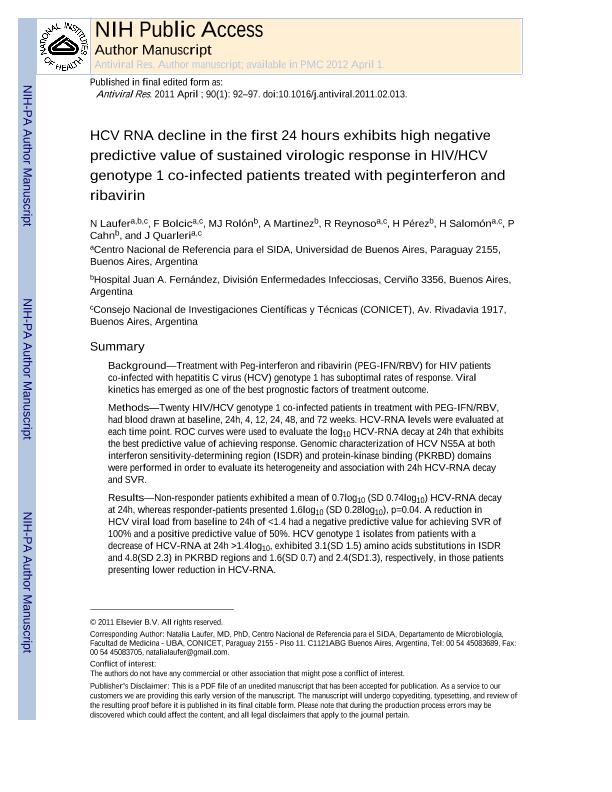Mostrar el registro sencillo del ítem
dc.contributor.author
Laufer, Natalia Lorna

dc.contributor.author
Bolcic, Federico Martin

dc.contributor.author
Rolón, M. J.
dc.contributor.author
Martinez, A.
dc.contributor.author
Reynoso, Rita Paola

dc.contributor.author
Pérez, H.
dc.contributor.author
Salomon, Horacio Eduardo

dc.contributor.author
Cahn, P.
dc.contributor.author
Quarleri, Jorge Fabian

dc.date.available
2017-02-20T21:00:03Z
dc.date.issued
2011-04
dc.identifier.citation
Laufer, Natalia Lorna; Bolcic, Federico Martin; Rolón, M. J.; Martinez, A.; Reynoso, Rita Paola; et al.; HCV RNA decline in the first 24 hours exhibits a negative predictive value of sustained virologic response in HIV/HCV co-infected patients treated with peginterferon and ribavirin; Elsevier Science; Antiviral Research; 90; 1; 4-2011; 92-97
dc.identifier.issn
0166-3542
dc.identifier.uri
http://hdl.handle.net/11336/13187
dc.description.abstract
Background: Treatment with Peg-interferon and ribavirin (PEG-IFN/RBV) for HIV patients co-infected with hepatitis C virus (HCV) genotype 1 has suboptimal rates of response. Viral kinetics has emerged as one of the best prognostic factors of treatment outcome. Methods: Twenty HIV/HCV genotype 1 co-infected patients in treatment with PEG-IFN/RBV, had blood drawn at baseline, 24h, 4, 12, 24, 48, and 72 weeks. HCV-RNA levels were evaluated at each time point. ROC curves were used to evaluate the log10HCV-RNA decay at 24h that exhibits the best predictive value of achieving response. Genomic characterization of HCV NS5A at both interferon sensitivity-determining region (ISDR) and protein-kinase binding (PKRBD) domains were performed in order to evaluate its heterogeneity and association with 24h HCV-RNA decay and SVR. Results: Non-responder patients exhibited a mean of 0.7log10 (SD 0.74log10) HCV-RNA decay at 24h, whereas responder-patients presented 1.6log10 (SD 0.28log10), p=0.04. A reduction in HCV viral load from baseline to 24h of <1.4 had a negative predictive value for achieving SVR of 100% and a positive predictive value of 50%. HCV genotype 1 isolates from patients with a decrease of HCV-RNA at 24h >1.4log10, exhibited 3.1(SD 1.5) amino acids substitutions in ISDR and 4.8(SD 2.3) in PKRBD regions and 1.6(SD 0.7) and 2.4(SD1.3), respectively, in those patients presenting lower reduction in HCV-RNA. Conclusions: HIV/HCV genotype 1 co-infected patients with a decrease in HCV-VL at 24h >1.4log10 are more likely to achieve SVR when treated with PEG-IFN/RBV than those with lower levels of HCV-RNA decay. Along with other host-related and viral-related prognostic factors in HIV/HCV co-infected patients, this very early time point of evaluation could be of relevance in the management of HCV-specific treatment.
dc.format
application/pdf
dc.language.iso
eng
dc.publisher
Elsevier Science

dc.rights
info:eu-repo/semantics/openAccess
dc.rights.uri
https://creativecommons.org/licenses/by-nc-nd/2.5/ar/
dc.subject
Hiv
dc.subject
Hcv
dc.subject
Svr
dc.subject
Treatment
dc.subject.classification
Enfermedades Infecciosas

dc.subject.classification
Ciencias de la Salud

dc.subject.classification
CIENCIAS MÉDICAS Y DE LA SALUD

dc.title
HCV RNA decline in the first 24 hours exhibits a negative predictive value of sustained virologic response in HIV/HCV co-infected patients treated with peginterferon and ribavirin
dc.type
info:eu-repo/semantics/article
dc.type
info:ar-repo/semantics/artículo
dc.type
info:eu-repo/semantics/publishedVersion
dc.date.updated
2017-02-15T14:08:36Z
dc.journal.volume
90
dc.journal.number
1
dc.journal.pagination
92-97
dc.journal.pais
Países Bajos

dc.journal.ciudad
Amsterdam
dc.description.fil
Fil: Laufer, Natalia Lorna. Universidad de Buenos Aires. Facultad de Medicina. Departamento de Microbiología. Centro Nacional de Referencia del Sida; Argentina. Consejo Nacional de Investigaciones Científicas y Técnicas; Argentina. Gobierno de la Ciudad de Buenos Aires. Hospital General de Agudos "Juan A. Fernández"; Argentina
dc.description.fil
Fil: Bolcic, Federico Martin. Universidad de Buenos Aires. Facultad de Medicina. Departamento de Microbiología. Centro Nacional de Referencia del Sida; Argentina. Consejo Nacional de Investigaciones Científicas y Técnicas; Argentina
dc.description.fil
Fil: Rolón, M. J.. Gobierno de la Ciudad de Buenos Aires. Hospital General de Agudos "Juan A. Fernández"; Argentina
dc.description.fil
Fil: Martinez, A.. Gobierno de la Ciudad de Buenos Aires. Hospital General de Agudos "Juan A. Fernández"; Argentina
dc.description.fil
Fil: Reynoso, Rita Paola. Universidad de Buenos Aires. Facultad de Medicina. Departamento de Microbiología. Centro Nacional de Referencia del Sida; Argentina. Consejo Nacional de Investigaciones Científicas y Técnicas; Argentina
dc.description.fil
Fil: Pérez, H.. Gobierno de la Ciudad de Buenos Aires. Hospital General de Agudos "Juan A. Fernández"; Argentina
dc.description.fil
Fil: Salomon, Horacio Eduardo. Universidad de Buenos Aires. Facultad de Medicina. Departamento de Microbiología. Centro Nacional de Referencia del Sida; Argentina. Consejo Nacional de Investigaciones Científicas y Técnicas; Argentina
dc.description.fil
Fil: Cahn, P.. Gobierno de la Ciudad de Buenos Aires. Hospital General de Agudos "Juan A. Fernández"; Argentina
dc.description.fil
Fil: Quarleri, Jorge Fabian. Universidad de Buenos Aires. Facultad de Medicina. Departamento de Microbiología. Centro Nacional de Referencia del Sida; Argentina. Consejo Nacional de Investigaciones Científicas y Técnicas; Argentina
dc.journal.title
Antiviral Research

dc.relation.alternativeid
info:eu-repo/semantics/altIdentifier/url/http://www.sciencedirect.com/science/article/pii/S0166354211000519
dc.relation.alternativeid
info:eu-repo/semantics/altIdentifier/doi/http://dx.doi.org/10.1016/j.antiviral.2011.02.013
dc.relation.alternativeid
info:eu-repo/semantics/altIdentifier/url/https://www.ncbi.nlm.nih.gov/pmc/articles/PMC3102437/
Archivos asociados
